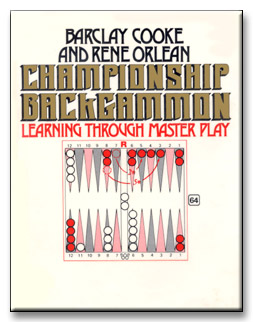|
| Magriel's NYT Columns |
 In backgammon tournaments, players are often vexed by the caprice of the dice. Although luck is an integral element of the game, many wish it could be reduced. In bridge competitions, the luck of the cards can be reduced by playing duplicate — that is, each pair is dealt the exact same cards at different tables.
In backgammon tournaments, players are often vexed by the caprice of the dice. Although luck is an integral element of the game, many wish it could be reduced. In bridge competitions, the luck of the cards can be reduced by playing duplicate — that is, each pair is dealt the exact same cards at different tables.
Backgammon can also be played duplicate-style, with players at different tables having the same dice rolls. In duplicate backgammon, the same opening rolls allow the player to get off to an equal start. Very early on, however, the games will tend to diverge. When this happens, the fact that the same numbers are being used at each table becomes irrelevant. Quite arbitrarily and unforeseeably, the same number may work well at one table but be a disaster at another.
One of the few significant tests of duplicate backgammon came during the World Championship Cup in London in 1973, between four of the world’s leading players. This event was a team match with Barclay Cooke and his late son, Walter, representing the United States, against Phillip Martyn and Joe Dwek, representing Europe.
 Barclay Cooke |  Walter Cooke |  Phillip Martyn |  Joe Dwek |
The identical rolls were played by opposing sides at both tables. The results of this match, with a detailed and highly instructive commentary on each play, are presented in Barclay Cooke’s new book, “Championship Backgammon” (Prentice Hall, Englewood Cliffs, N.J., 1980).
An informative example of how the duplicate format works may be seen in the diagrammed position taken form “Championship Backgammon.” In the two simultaneous games, the first two rolls for each side were played identically. Thus, on the third roll, the same position was reached with Black to play 3-2.
|
| Black to play 3-2. |
Phillip Martyn decided to split his back men by playing 24/21. With this play, Black hopes to next establish the 21-point, or else escape with one of his back runners. Cooke, well known for his determination to keep an anchor in his opponent’s board, chose to play his 3, 13/10, creating another builder.
|
11/9, 24/2 |
11/9, 13/10 |
The correct play, then, is Cooke’s conservative choice: 13/10, 11/9. Black consolidates his gains, while leaving White to struggle with his unwieldy position.
The alternate play, 24/21, exposes both of Black’s back men, inviting an immediate attack. Now, many of White’s rolls, which would otherwise be awkward, become playable: White may be able to activate his excess men on the 19-point; White may be able to hit and point on Black on the 21-point (10 combinations out of a possible 36); White may hit one or both of Black’s back men. Thus, splitting is likely to result in a wild, tactical melee in which neither side has a clear advantage.
Rollout
 Tom Keith 2013 |
|
Money play Centered cube Black rolls 3-2 1296 games with VR Checker play: 2-ply Cube play: 3-ply Red |
| 3-2: | Game | G | BG | Equity | ||||
| 1 | 13/10, 11/9 |
W L |
.5399 .4601 |
.1716 .1586 |
.0092 .0126 | +0.1425 |

| Cooke |
| 2 | 24/21, 11/9 |
W L |
.5328 .4672 |
.1638 .1878 |
.0107 .0071 | +0.0826 | (0.0599) | Martyn |

|
|

